What Is The Yellow Black And White Caterpiller In My Garden
If you ask any gardener, there are very few "good caterpillars." These eating machines can lay waste to a garden over the course of a few days and nights, often leaving vegetables inedible and dying.
A few caterpillars, though, are worth celebrating. Among them is the woolly bear caterpillar, a familiar fall sight in cooler regions of North America. Another favorite is the caterpillar that becomes a monarch butterfly. That caterpillar is often reared in special cages as part of a school's science curriculum.
After those two favorites, the idea of good caterpillars fades fast. In their place is a long list of vegetable, fruit, berry and tree marauders. While these caterpillars serve a place in the ecology of an area, it can be hard to convince any gardener that they should be tolerated since they can so quickly decimate a season's worth of hard work.
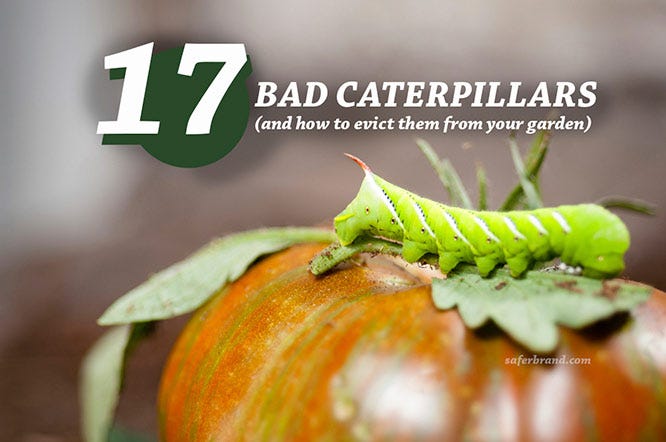
What Are Caterpillars?
Caterpillars are not a type of animal in the same way as, for instance, cats. They are not an individual species or group of species. Instead, caterpillars are the larvae form of butterflies or moths, both of which are insects in the order of Lepidoptera.
Most caterpillars share a number of characteristics, including an elongated body and a hardened head capsule. While it may seem like caterpillars have dozens of legs, the truth is they have only six real legs. Additional sets called "prolegs" are stumpy, used for climbing and not present in their adult form.
Beyond those features, caterpillars can vary widely in appearance. Some have hair, some have spots or stripes and they come in a variety of colors, too.
What Do Caterpillars Eat?
For the most part, caterpillars eat plants to bulk up and fuel the transition into the pupal stage of life. Which plants do they eat? It varies from species to species, which explains why some plants are so vigorously attacked – it's often the only suitable food available.
What Eats Caterpillars?
Almost every caterpillar can fall victim to a hungry bird. Caterpillars are full of protein and often easy targets for birds. What's a little more surprising is that wasps and other insects regularly target caterpillars.
Those wasps may eat the caterpillar directly, but are far more likely to use the caterpillar as a host for their own larvae. They lay eggs on the caterpillar, and their larvae eat the host caterpillar as the wasp larvae grow.
Caterpillars on Your Hit List
Many caterpillars are out to destroy your favorite plants, whether they're after a seasonal vegetable, berries or a favorite tree. Some even target your lawn! Here's a look at some of the worst:
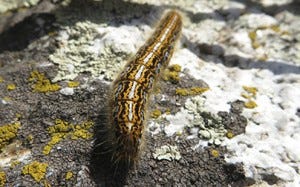
Armyworm
Armyworm –The armyworm is so named for its troop-like procession as a group eats through all available food sources. Once done, the group marches to the next available food source, essentially decimating all vegetation in its path.
- Targets: Grass, oats, wheat, fall rye, corn, barley, bean, cabbage, carrot, onion, pea, pepper, radish, sweet potato
- Features: Mature larvae are about 1 ½ inches long and are dark green to black. Sides have white, orange and brown stripes.
- Eradication: Safer® Brand Insecticide, biological control, parasitic flies, predation
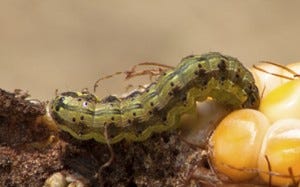
Bollworm
Bollworm –Several species of bollworm exist and many prefer to target cotton plants but they will also infest many other garden vegetables. One species, the corn earworm, is listed below in its own entry.
- Targets: Cotton, tomato, corn, okra, soybean, potato, pigeon pea, chickpea, cow pea, sorghum, rice,
- Features: Green and yellow to red-brown in color with a yellow head. Dark stripes along the 1 1/2-inch-long body.
- Eradication: Safer® Brand Insecticide, biological control, careful weeding, winter watering
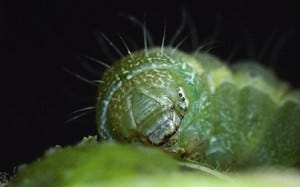
Cabbage Looper
Cabbage loopers –This well-camouflaged caterpillar chews a variety of holes in cabbage leaves and is a serious pest in many gardens.
- Targets: Cabbage, cauliflower, broccoli, Brussels sprouts, many other vegetable crops
- Features: Green with two white lines down the back and one along each side. Measuring about 1 ½ inches, they move in an inch-worm fashion.
- Eradication: Safer® Brand Insecticide, biological control, hand picking, row covers, weed control in off season
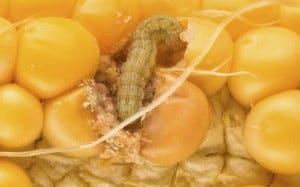
Corn Earworm
Corn earworm (also called tomato fruitworm) –Many consider the corn earworm to be one of the top North American insect pests based on the financial damage it causes to a wide variety of crops.
- Targets: Primarily corn and tomato, but many other vegetables, field crops, weeds, fruit and berry plants are occasional targets
- Features: Larvae have an orange or light brown head with a body that can be a variety of colors, including brown, green, pink, yellow or black. Pupae are a mahogany brown.
- Eradication: Safer® Brand Insecticide, biological control
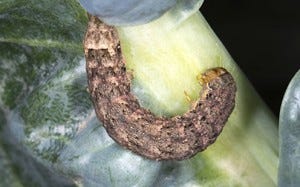
Cutworm
Cutworm –This caterpillar usually attacks a young garden at night, literally chewing through the stem of a young plant. This tactic usually kills the plant shortly thereafter.
- Targets: Most garden crops
- Features: Dull brown caterpillar that measures 1 to 2 inches. Additional markings help it blend in with the soil.
- Eradication: Safer® Brand Insecticide, keeping your garden sparse of other plants or weeds, protective borders around stems, hand picking at night
Diamondback Moth –Cabbage and related plants are the prime food for this caterpillar, which probably came from Europe but is now found on several continents including North and South America.
- Targets: Cabbage, broccoli, Brussels sprouts, cabbage, cauliflower, collard, watercress, turnip, radish
- Features: Green with white spots on a half-inch body that is mostly hairless.
- Eradication: Safer® Brand Insecticide, biological control, heavy rainfall
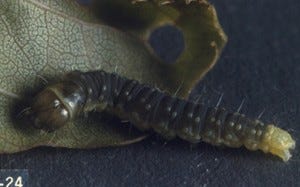
Fruittree Leafroller
Fruittree leafroller –Feeds on new leaves, giving them a ragged appearance. In order to pupate, they roll and tie fruit tree and ornamental leaves together. Several species of leafroller caterpillars exist.
- Targets: Apple, apricot, cherry, pear, plum, prune, quince, raspberry, currant, loganberry, blackberry, gooseberry, English walnut, ash, box elder, elm, locust, oak, poplar, willow, rose
- Features: Green with a black head that turns brown as it ages.
- Eradication: Insecticide, parasitic wasps
Green Cloverworm –From from the East Coast to the Great Plains, this worm is commonly found in soybean fields, although it rarely reaches pest levels.
- Targets: Soybeans, alfalfa, bean, clover, cowpea, strawberry, vetch
- Features: Pale green with one or two white stripes on each side of the half-inch body.
- Eradication: Safer® Brand Insecticide, biological control, predators, cleaning up debris
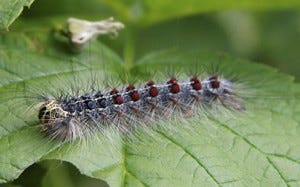
Gypsy Moth
Gypsy moth caterpillar– This invasive insect has been spreading from the Northeast since 1900 and reached epidemic proportions in 1980 and 1981. Since that time, massive outbreaks have been rare.
- Targets: Oak, maple, elm, apple, birch, alder, poplar, willow
- Features: Look for five pairs of blue spots followed by six pairs of red on its back.
- Eradication: Safer® Brand Insecticide, trapping with burlap rings set at eye level on the trunk
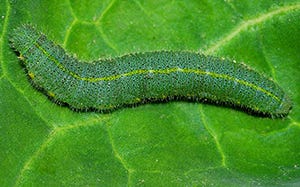
Imported Cabbageworm
Imported cabbageworm – First observed in Quebec, Canada, in the 1860s, by the 1880s it had spread to the Rocky Mountains. It's now widespread through much of North America.
- Targets: Cabbage, cauliflower, collard, broccoli, Brussels sprouts, horseradish, kale and kohlrabi. Occasionally found on some flowers.
- Features: Green, velvety appearance measuring a little more than an inch long.
- Eradication: Safer® Brand Insecticide, biological control, row covers
Mimosa webworm – Introduced to the U.S. in the 1940s, this pest spins a web around leaflets and then feeds inside this protective sack.
- Targets: Mimosa, honeylocust
- Features: A bit longer than a half-inch, it has a slender gray or dark brown body with five white stripes.
- Eradication: Safer® Brand Insecticide, biological control
Orange tortrix –This pest is generally found in California, Oregon and Washington state where they usually target grape plants and make webbing nests among berry clusters. Its feeding habits usually trigger rot around soft tissues.
- Targets: Apple, grape, avocado, citrus, blackberry, dewberry, raspberry
- Features: Straw-colored with brown heads. A total length of ½ inch.
- Eradication: Safer® Brand Insecticide, careful cleaning and weeding, parasitic wasps, spiders
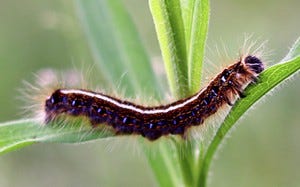
Eastern Tent Caterpillar
Tent caterpillar, Eastern – Tent caterpillars, the eastern tent, in particular, were first observed as far back as 1646, and these tent caterpillars experience population outbreaks every eight to 10 years. The presence of tent worms is usually indicated by the appearance of silky bags attached to the crooks of trees.
- Targets: Cherry, crabapple, apple. Occasionally attacks other deciduous trees and shrubs.
- Features: Hairy, yellowish-brown 2-inch-long caterpillars with a row of blue spots on their backs.
- Eradication: Insecticides, removal of nests, removal of egg masses, parasitic wasps, predators
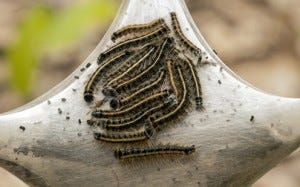
Western Tent Caterpillar
Tent caterpillar, Western –This early-season defoliator usually hita host plants in May and June. Its silken tent is usually the first sign of an infestation.
- Targets: Aspen, willow, poplar, cottonwood, mountain mahogany, birch, apple, plum, cherry, oak
- Features: Two-inch-long black body with a white stripe down the back.
- Eradication: Safer® Brand Insecticide, removal of nests, removal of egg masses, parasitic wasps, predators
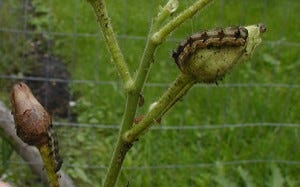
Tobacco Budworm
Tobacco budworm –This light-colored caterpillar bores into the buds and blossoms of a variety of plants. It is closely related to the corn earworm.
- Targets: Tobacco, soybean, flax, cotton, clover, alfalfa, tomato, lettuce, cabbage, cantaloupe, pea, squash and many others, including weeds and flowers
- Features: Green-tinted body with white bands that measures about 1 ½ inches.
- Eradication: Safer® Brand Insecticide, biological control, parasitic wasps, weeding
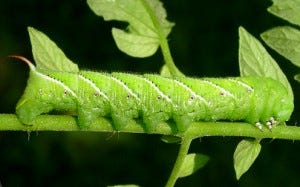
Tomato Hornworm
Tomato hornworm –This major garden pest targets the upper portions of its host plants with its voracious appetite. Gardeners often have a hard time spotting these large caterpillars because their color camouflages them so well.
- Targets: Tomato, eggplant, pepper, tobacco, moonflowers, potato
- Features: A pudgy green caterpillar with v-shaped markings on its sides. A black horn-like protrusion juts from its backside, giving its name.
- Eradication: Safer® Brand Insecticide, biological control, hand picking, parasitic wasps, weeding to limit egg-laying opportunities
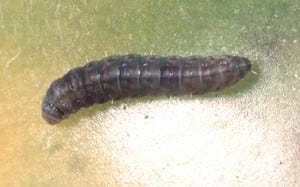
Tomato Pinworm
Tomato pinworm –Look for this pest in perpetually warm states, including Texas, California and Florida. Outside of these areas, this worm may appear in greenhouses.
- Targets: Tomato, eggplant, potato, nightshade family
- Features: Larvae are tiny (about 1/3 of an inch) and yellowish gray with a small head. Pupae start out green and turn brown and measure about 1/5 of an inch.
- Eradication: Insecticide, parasitic wasps, thorough cleanup at the end of the growing season since pupae hide in ground debris
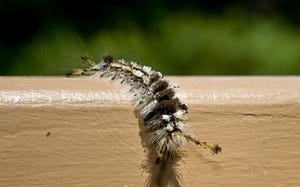
Tussock Moth Caterpillar
Tussock moth caterpillar – Found in the south, this hairy caterpillar can defoliate small trees and they assemble hard-to-scrape-off cocoons. Watch out, their hair can be irritating to the skin.
- Targets: Oak, bald Cyprus, cherry, hackberry, willow, maple, birch
- Features: Three species exist, but they all have black tufts of hair at the head and rear.
- Eradication: Safer® Brand Insecticide, placing individuals in soapy water or removal of cocoons.
How to Get Rid of Caterpillars
Safer® Brand has several solutions to battle the caterpillars ravaging your lawn, garden and flowerbeds.
Two potent caterpillar fighting products that use biological control are garden dust and Caterpillar Killer, like our Safer® Brand Caterpillar Killer. These solutions incorporate a bacteria to attack the caterpillar from its inside. Once applied to foliage that the caterpillars ingest, the bacteria (bacillus thuringiensis) releases a deadly toxin in the insect's gut that causes it to stop eating and starve to death. As further measure, the bacteria begin colonizing the creature, eating it alive from the inside.
A third product, Insect Killing Soap, like our Safer® Brand Insect Killing Soap, will eliminate caterpillars by using potassium salts of fatty acids to break down the caterpillars' head capsule. Safer® Brand's Insect Killing Soap, Garden Dust and the 16 oz. Caterpillar Killer are also certified by OMRI to make them compliant for use in organic production.
Additional methods for fighting caterpillars include hand-picking the insects off affected plants, encouraging predators and removing nests and egg masses from the area. Many gardens will also benefit from a thorough cleanup of debris around the garden at the end of the season since many species will overwinter in leaf litter.
Your Battles with Caterpillars
Are you at odds with some caterpillars in your garden? Let us know all about your struggles! Take a picture of one of the little devils and share it with us when you visit Safer® Brand on Facebook, where you can join in on the conversation with the organic gardening community!
Looking for good info on our products? Subscribe to the Safer® Brand E-Newsletter for special tips and articles to help you in your organic journey.
What Is The Yellow Black And White Caterpiller In My Garden
Source: https://www.saferbrand.com/articles/plant-vs-caterpillars
Posted by: fultshishly.blogspot.com

0 Response to "What Is The Yellow Black And White Caterpiller In My Garden"
Post a Comment